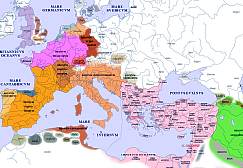

An Online Encyclopedia of Roman Emperors
Euphemia (wife of Justin I)
Geoffrey Greatrex
University of Ottawa Very little is known of the life of Justin I's wife Euphemia. Her original name was Lupicina, a name which may have been associated with the occupation of prostitute.[[1]] Certainly her origins were humble: as Procopius relates (Anecdota/Secret History 6.17), she had been born a barbarian and a slave. Before marrying Justin she had been the concubine of her previous owner.2]]
When Justin ascended the throne in July 518, both he and his wife were already at an advanced age (Proc. Anecdota/Secret History 6.17). Probably as soon as Justin was acclaimed as emperor in the hippodrome, the people there assembled (primarily the circus partisans) clamoured that Lupicina change her name to the more respectable Euphemia (Theophanes, A.M. 6011); and thus she was known henceforth.[[3]] The name was appropriate, for Euphemia of Chalcedon, a local saint, was associated with the Council of Chalcedon (A.D. 451); and both Justin and his wife were zealous upholders of the decisions of this council (unlike Justin's predecessor, Anastasius I).[[4]]
As empress, we are told, again by Procopius (Anecdota/Secret History 9.47), that she did not interfere at all in affairs of state. She favoured her husband's nephew and eventual successor, Justinian, but adamantly opposed his marriage to the unrespectable Theodora. Only once she had died, some time before November 524, was it possible for Justinian to organise the removal of the legal impediments to his marriage to a former actress.[[5]]
Like many other prominent figures in Constantinople, Euphemia had correspondence with the bishops of Rome; some letters to her from Hormisdas (514-523) survive and one written in her name to him. Little can be gleaned from these letters,[[6]] save perhaps an indication of the empress's piety, attested also by her construction of a convent and church of St Euphemia. Here she was buried; and upon his death, Justin I was entombed with her.[[7]]
Bibliography
Alan Cameron, Circus Factions. Blues and Greens at Rome and Constantinople (Oxford, 1976)
D. Daube, `The marriage of Justinian and Theodora. Legal and theological reflections', Catholic University of America Law Review 16 (1967), pp.380-99
T. Honoré, Tribonian (London, 1978)
A. Vasiliev, Justin the First (Cambridge, MA, 1950)
Geoffrey Greatrex 16 January 2000
[[1]] Vasiliev, Justin I, p.61 and n.39, connecting the name with the Latin lupa (she-wolf) and lupanar (a brothel).
[[2]]As Daube, `The marriage of Justinian and Theodora', pp.385-6 notes, there were legal obstacles to a member of the aristocracy marrying a former slave. He suggests therefore that Lupicina was granted the status of freeborn in order to legitimise their union. This must have occurred during the reign of Anastasius, when Justin's career prospered.
[[3]]The wife of Tiberius II, Ino, was similarly called upon to change her name (to Anastasia). Cf. Cameron, Circus Factions, pp.145-6. St Euphemia of Chalcedon (a local saint therefore) was particularly associated with the Council of Chalcedon.
[[4]] See J.A.S. Evans' entry on Justin I's support for Chalcedon. Euphemia's own support for the council is singled out by Pseudo-Dionysius of Tel-Mahre (tr. W. Witakowski, 1996), p.18.
[[5]]Even before then, however, he had succeeded in raising her to the rank of patrician (presumably in spite of Euphemia's objections). See Honoré, Tribonian, pp.9-10; Vasiliev, Justin I, p.98 puts Euphemia's death in 523 or 524. There is a certain irony in the fact that (as Honoré notes) the stain of Theodora's previous disreputable career was removed in the same way as Euphemia's must have been (for her marriage to Justin to have been legally valid, cf. n.2 above).
[[6]]Honoré, Tribonian, p.231 argues that neither Justin nor Euphemia can have been the authors of their letters preserved in the Collectio Avellana (vol.2, ed. O. Günther, CSEL 35); he suggests that the quaestor Proculus may have drafted them. The letters are nos. 156, 194, 203; cf. Vasiliev, Justin I, pp.171, 188, 199.
[[7]]See Vasiliev, Justin I, p.91 and p.92 n.69 for the sources on the convent and church.
Copyright (C) 2000, Geoffrey Greatrex. This file may be copied on the condition that the entire contents, including the header and this copyright notice, remain intact.
Comments to: Geoffrey Greatrex.
Updated:16 January 2000
For more detailed geographical information, please use the DIR/ORBAntique and Medieval Atlas below. Click on the appropriate part of the map below to access large area maps.
